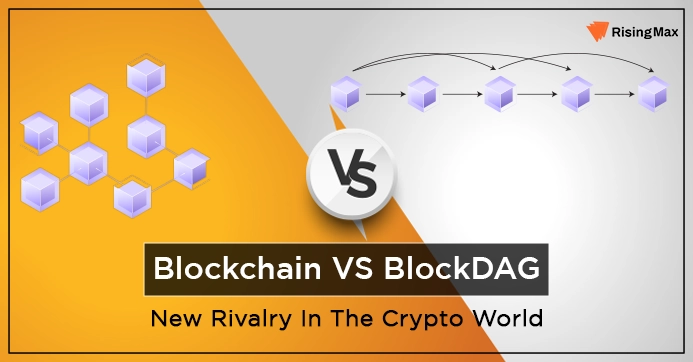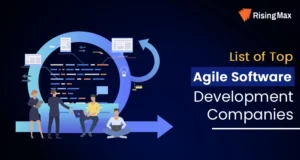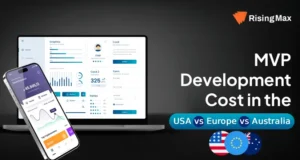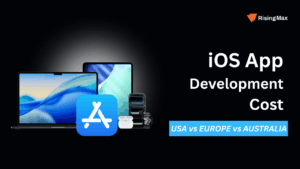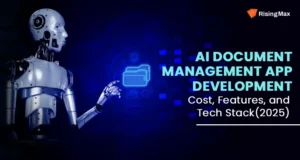Blockchain enjoyed its monopoly in the crypto world until the arrival of Blockchain DAG, a new kid in the decentralized technology world. Blockchain DAG (Directed Acyclic Graph) is another type of decentralized technology that is nowadays commonly referred to as “Blockchain Killer.”

Even though the Directed Acyclic Graph is new to the crypto world, it holds a superiority over the blockchain. When it comes to Blockchain vs. Blockchain DAG, there are similarities such as Pow & PoS, the concept of blockchains, and the directional chain rule. DAG-based blockchain and blockchain are different from each other and are considered arch-rivals.
RisingMax Inc., as a leading blockchain development company, empowers businesses worldwide to align with the changing tech trends. Our team leverages their superior blockchain expertise and hands-on development experience to build business solutions that are future secure. Connect with our experts to integrate blockchain-powered business solutions and explore new growth opportunities with blockchain.In this post, we will discuss the following:
- What is Blockchain DAG?
- How Does a Blockchain DAG works?
- What is Blockchain DAG Architecture?
- Advantages of DAG-Based Blockchain Over Traditional Blockchain
- Blockchain vs Blockchain DAG: Key Differences.
- Blockchain vs Blockchain DAG: Which One is better?
Solana Blockchain Development Company
What Is Blockchain DAG?
A blockchain DAG is a decentralized and distributed system with similar benefits to blockchain but with a more directed system. Blockchain DAG provides users with the same secure environment to carry out transactions as in blockchain.
As compared to the blockchain, blockchain DAGs are less time-consuming as transactions are confirmed based on previous transactions and not based on PoW. Proponents believe that blockchain DAG will overtake blockchain as it is an environment-friendly alternative.
How Does a Blockchain DAG works?
To understand the working of a DAG-based system, you need to focus on three alphabets i.e., D.A.G.
- D – directional
- A – Acyclic
- G – Graph
The graph in the blockchain DAG represents the system’s overall architecture and defines the data flow. The acyclic in blockchain DAG represents that the data flow can’t be cyclical or follow a particular route. The directional in a DAG-based system represents the directional flow of data toward a final destination.
To understand the working of DAG-based blockchain, imagine ordering a product from an eCommerce website. Irrespective of the starting location of the product, your order will always follow a direction toward its destination i.e., you. Orders moving backward represent that there’s something wrong with the system.
Blockchain IoT Development Company
What Is Blockchain DAG Architecture?
There are two main components in a DAG-based blockchain architecture:
- Vertices
- Edges
Vertices – In blockchain DAG architecture, the vertices represent transactions. Each transaction in a DAG-based system is built on top of the previous one, creating a chain-like directional structure.
Edges – In a DAG-based system, the edges show the direction of flow. Blockchain DAG structure is acyclic in nature with a directed flow like a river.
To deter spammers, the DAG-based system utilizes a small proof of work (PoW). For simple understanding, you can compare a DAG-based system with a family tree. Every new transaction in blockchain DAG starts without any parent and ends with no kids, thus creating a chain-like structure.

Advantages of DAG-Based Blockchain Over Traditional Blockchain
The DAG-based blockchain works on new decentralized technology consensus, giving it an advantage over traditional blockchain technology. Here are some of the advantages of DAG-based blockchain over the traditional blockchain.
Faster
DAG-based blockchains enjoy faster transaction speed the traditional blockchains. Currently, bitcoin processes four to seven transactions per second, and some altcoins can process up to 1000 transactions per second. However, a DAG-based blockchain can process hundreds of thousands of transactions per second.
Scalable
The DAG-based blockchain solves the Proof of work issue, which proves a major hindrance with the traditional blockchains. Blockchain DAG, instead of PoW consensus, uses previous transactions as proof to carry out transactions. Thus enabling them to effectively address the scalability issues and process a higher number of transactions per second than traditional blockchains.
Mining Free
Traditional blockchains like Ethereum, Bitcoin and other coins employ consensus algorithms for the mining process. However, DAG-based systems are mining-free. This adds to the efficiency of blockchain DAGs and enables DAG-based systems to process a higher number of transactions per second.
Affordable
The faster transactions and data processing speeds make DAG-based blockchains more affordable than most public blockchains. There are no minor consensus protocols that hamper the overall efficiency and efficiently carry out more transactions. And that too without any additional transaction fees.
Energy Efficiency
DAG-based blockchain systems don’t use PoW consensus mechanisms, thus making them energy efficient. The direct acyclic graph blockchain becomes an eco-friendly blockchain option than most PoW-powered blockchain options out there.
Enterprise Blockchain Development Company
Blockchain vs Blockchain DAG: Key Differences
Now you have read about the Blockchain DAG, its advantages, and its use cases. Let’s move further and discuss in depth blockchain vs blockchain DAG key differences that make it a #blockchain killer. Let’s analyze these key differences between both technologies one by one.
Mining
Mining is the most common process to extract new coins and facilitate ongoing transactions in the blockchain system. The mines solve the complex computation problems associated with the transactions and award new tokens for their efforts. Most popular blockchains, such as Ethereum and Bitcoin, use proof of work and proof of stake consensus to reward the miners.
In the case of blockchain, new tokens can be attained by the participants via different consensus methodologies. While in blockchain DAG, there is no need for a consensus mechanism, as past transactions are used for validations.
Number of Transactions
Although blockchain gained traction in the digital finance world for faster transactions, blockchain DAGs are quicker. There is no waiting time or PoW/PoS consensus in DAG-based systems, thus ensuring the processing of a higher number of transactions. In addition, DAG-based systems improve scalability and have a unique data structure.
Data Structure
Blockchain and DAG are other types of distributed ledger technology (DLT). Blockchain creates an endless chain of blocks to store transactions. This means that each newly created block is responsible for putting new data in the next block. And all the information gets sealed using encryption technology. However, a DAG-based system follows directional data storage where a layer is atop one another.
Validation Methodology
To carry out a secure transaction in a blockchain system, the miners or validators can either approve or disapprove the transactions. This validation methodology in blockchain creates a secure environment to carry out transactions. However, in the DAG blockchain, the validation of a transaction depends upon the previous transaction.
Inception
Blockchain was introduced to the tech world in 2008 when Satoshi Nakamoto anonymously released its whitepaper. On the other hand, the DAG-based system came into the spotlight in 2015.
Popularity
There are many networks utilizing blockchain technology today. Some of the few networks running on a blockchain are Bitcoin, Ethereum, Tezos, and IOTA. By using blockchain technology, other private startups or organizations also have private networks.
Thus dissimilar to blockchains, Directed Acyclic Graphs have lower network numbers running on them. NXT, Tangle, and Byteball are the most popular.

DAG vs Blockchain
| Blockchain vs Blockchain DAG | ||
| Blockchain | Blockchain DAG | |
| Inception | Launched in 2008, when Satoshi Nakamoto related Bitcoin white paper. | Came into existence in 2015 with the introduction of the NXT platform. |
| Structure | Blockchain forms a chain structure where each block representing a transaction is arranged in chronological order. | DAG-based blockchain form a directional graph-like structure. Each node in a DAG needs to be verified and linked with previous transactions, thus forming a directional chain structure. |
| Consensus Mechanism | Blockchain uses a Proof of work “PoW” consensus mechanism to reward validators and miners for each successful verification. | The DAG-based system relies on previous transactions for validation of the next transaction. |
| Affordability | High network fees, slow transaction processing time, and speed make blockchain an expensive option. | Low network fees process a large number of transactions, and fast speed makes DAG-based blockchain an affordable option. |
| Popular Network |
|
|
| Transaction Processing Speed | The block time in the blockchain reduces the transaction processing speed. | The DAG-based system uses previous transactions to verify the next thus speeding up the entire process. |
| Secure | The decentralized nature of blockchain technology makes it more secure than a DAG-based blockchain. | The semi-centralized nature of blockchain DAG makes it susceptible to attacks or manipulation. |
| Eco Friendly | The validation and mining process requires a large amount of energy, making blockchain less eco-friendly. | The DAG-based system becomes an eco-friendly option as there is no validation or mining process. |
| IoT Support | Blockchain doesn’t support IoT. | DAG-based blockchain supports IoT. |
| Number of Transactions | Block time limits the blockchain to carry out a large number of transactions. | Blockchain DAGs are fast and can efficiently carry out a large number of transactions within seconds. |
Unity Game Development Company
Blockchain vs Blockchain DAG: Which One is better?
Both blockchain and blockchain DAG are suitable for carrying out different operations efficiently based on business requirements. There’s no clear winner between blockchain and blockchain DAG. However, you can choose blockchain or DAG technology based on your personal and business needs or transaction requirements.
Blockchain DAG becomes a more viable option for apps or businesses that need to move data quickly, and cheaply, and process large chunks of low-value transactions. The same will become more time-consuming and costly with the blockchain.
However, blockchain becomes a more viable option in case a business is looking to transfer a large sum of money with speed, and transaction fees are less important.
The centralized nature of blockchain DAGs make them more susceptible to manipulation, thus failing to create a secure environment for carrying out transactions with large sums of money. In this scenario, waiting a day makes more sense as secure transactions become a paramount priority.

